Digital TV SOC Market Size
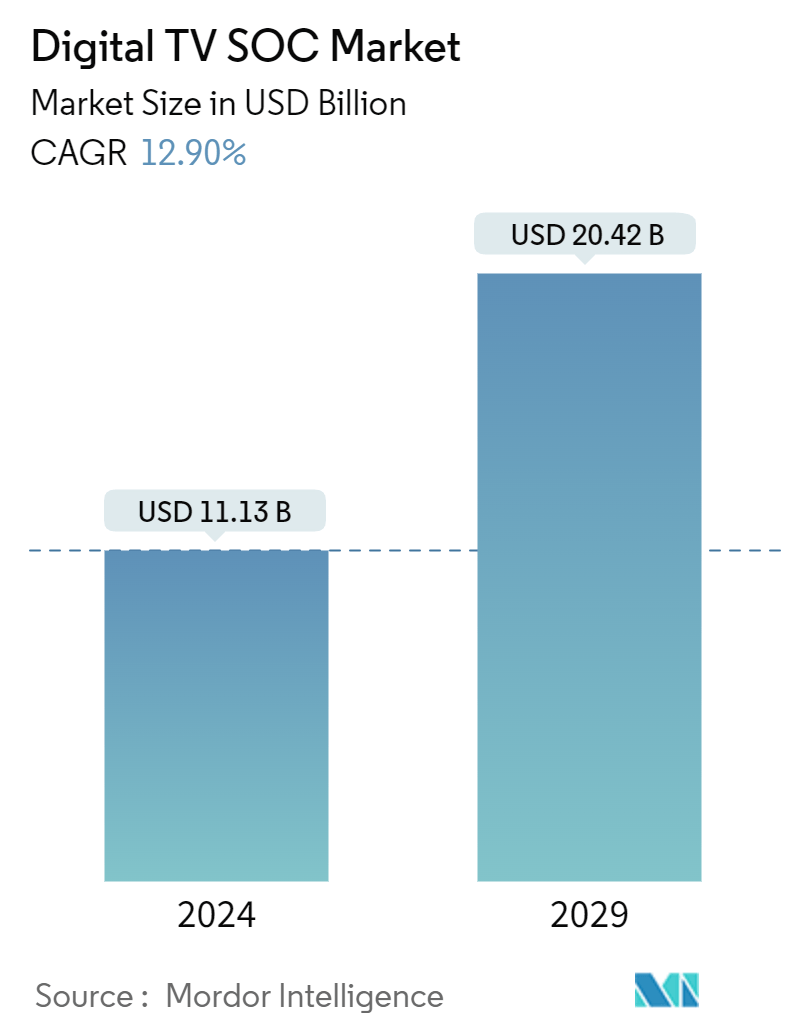
| Study Period | 2019 - 2029 |
| Market Size (2024) | USD 11.13 Billion |
| Market Size (2029) | USD 20.42 Billion |
| CAGR (2024 - 2029) | 12.90 % |
| Fastest Growing Market | North America |
| Largest Market | Asia Pacific |
| Market Concentration | Low |
Major Players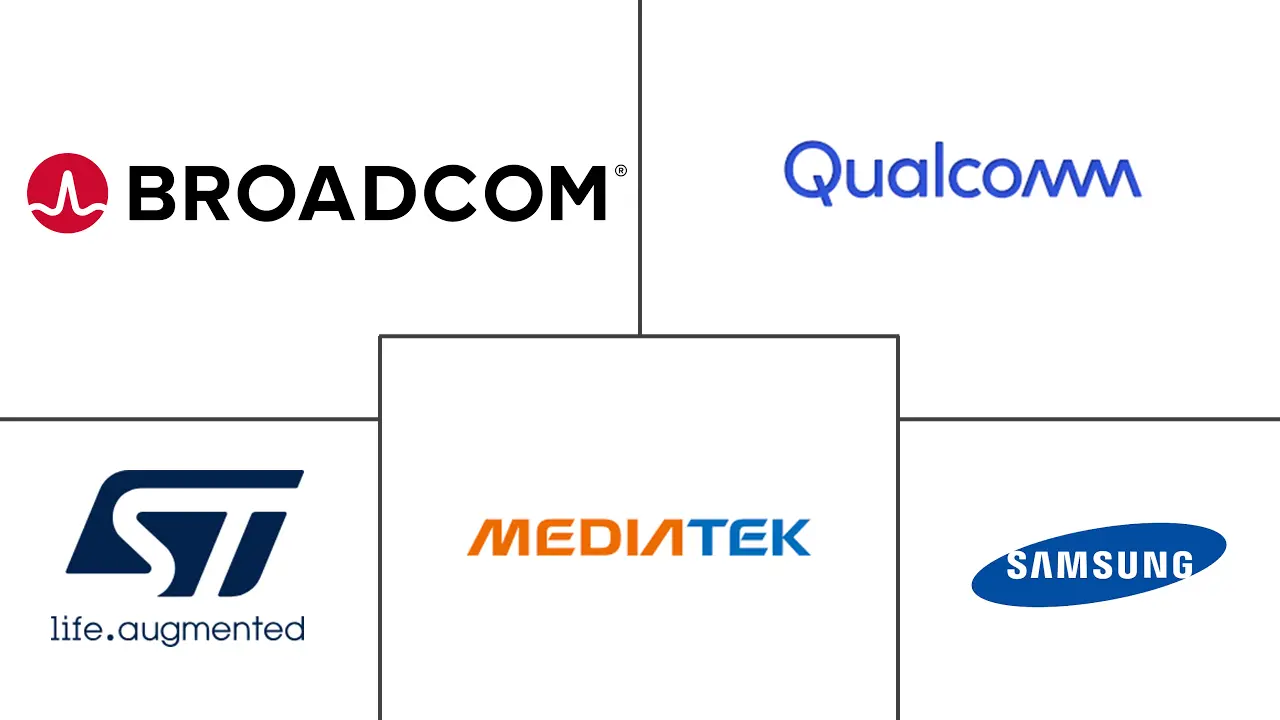
*Disclaimer: Major Players sorted in no particular order |
Digital TV SOC Market Analysis
The Digital TV SOC Market size is estimated at USD 11.13 billion in 2024, and is expected to reach USD 20.42 billion by 2029, growing at a CAGR of 12.90% during the forecast period (2024-2029).
- The shift from analog to digital television has led to a substantial rise in the demand for digital TV system-on-chips (SoCs). These SoCs enhance video and audio quality while offering a range of features such as interactive television, support for multiple languages, and electronic program guides. Digital television presents numerous advantages over its analog counterpart, including superior picture clarity, improved sound quality, and an increased number of available channels.
- Consequently, in recent years, numerous countries have transitioned from analog to digital television. This change necessitates the development of new digital television infrastructure, which includes digital TV receivers, set-top boxes, and various other devices capable of decoding and displaying digital television signals.
- Moreover, the emergence of smart televisions and online streaming platforms has led to the evolution of set-top boxes, which now incorporate these technologies to offer users effortless access to digital content and services. The expansion of this industry is fueled by a growing consumer appetite for premium entertainment and the widespread adoption of digital broadcasting standards throughout the globe.
- Furthermore, the advent of the system-on-chip (SoC) technology has revolutionized the functionality of digital signage across various sectors. SoC refers to a technology that consolidates all essential computing components onto a single, compact board. This advancement allows commercial display panels equipped with embedded SoC technology to function as digital signage media players, eliminating the necessity for external players. This innovation not only reduces costs and complexity but also streamlines the management of digital signage networks.
- The recent advancements in television and smartphone technology, along with the swift progress of new multimedia devices, interactive services, wireless communication, and internet infrastructure, have significantly heightened the demand for superior-quality multimedia. This surge is propelling the digital TV SoC market to unparalleled heights globally.
- However, the market studied encounters numerous challenges that may affect its growth and profitability. It is characterized by intense competition, with numerous companies providing comparable products. Furthermore, the expenses associated with the design and production of digital TV SoCs are considerable.
- Macroeconomic elements, including variations in exchange rates and the dynamics of international trade, may influence the global market for digital TV SoC. Alterations in currency values can affect the expenses associated with imported SoC products and raw materials, thereby impacting the pricing strategies and profitability of manufacturers and distributors in the digital TV SoC market.
Digital TV SOC Market Trends
The Commercial Segment is Expected to Hold a Significant Market Share
- The primary factors influencing the market for digital TV SoC in the commercial segment are the rising demand for high-definition content, the shift toward digital broadcasting, and the increasing popularity of internet-based streaming services.
- System-on-chip (SoC) digital signage generally consumes less electricity compared to external media players, resulting in lower energy costs and enabling companies to adopt more sustainable technological solutions. For instance, hotels are transitioning from traditional guest room televisions and external media players to smart TVs, which significantly lowers their power usage. This scenario is a replicable example of various businesses actively pursuing sustainability initiatives.
- In the commercial segment, the initial users of digital TV system-on-chip (SoC) technology have predominantly included operators of quick-service restaurants, along with retailers and marketers who recognize the advantages of substituting printed materials with digital alternatives. In the context of quick-service dining, sleek, lightweight, and nearly cord-free SoC displays are replacing traditional printed menu boards positioned above and behind order counters.
- Thus, the expansion of quick-service restaurants worldwide is expected to support the demand for the digital TV SoC market. For instance, according to Snacking.fr, in 2023, McDonald's emerged as the leading quick-service restaurant (QSR) chain in France, boasting the largest number of locations. The company operated 1,560 outlets within the country, reflecting an increase of 18 units compared to the prior year. Following McDonald's in the rankings were Marie Blachère and Lagardère Travel Retail France, with 793 and 707 units, respectively.
- Moreover, digital display systems and content management tools, such as MagicINFO, enable operators to update featured items and pricing according to the time of day, allowing for modifications to be made within minutes, in contrast to the days or weeks typically required for the production and delivery of new printed materials.
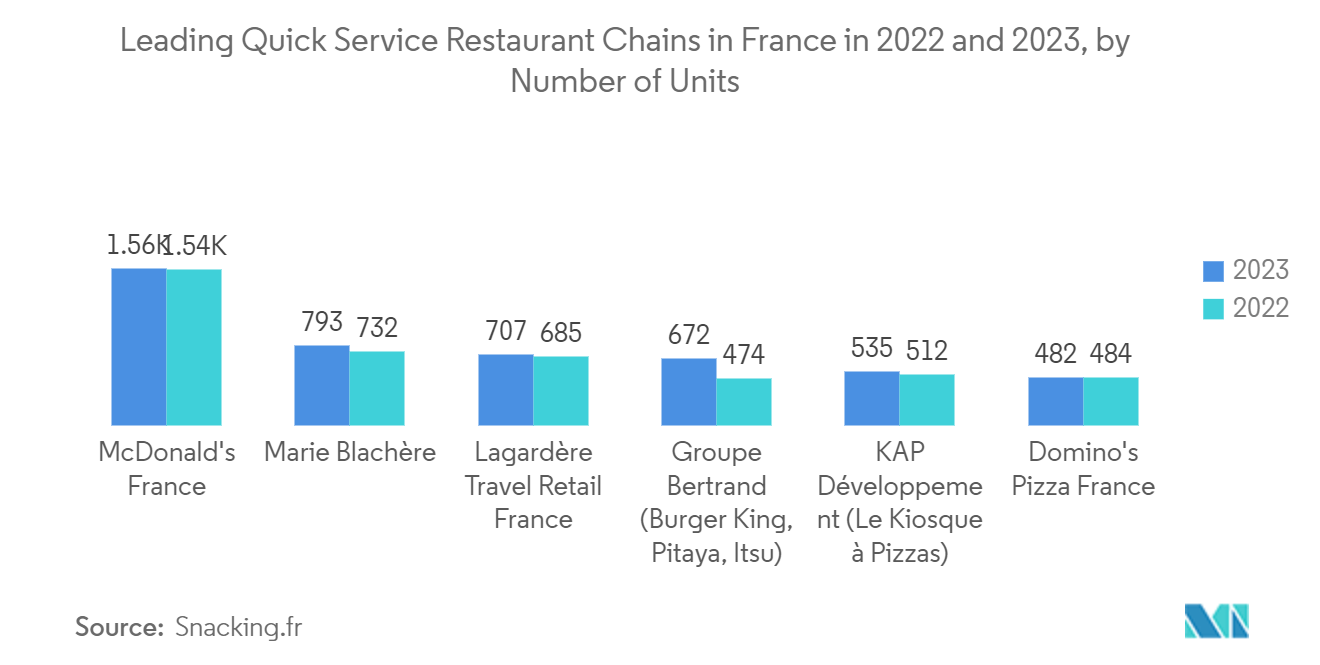
Asia-Pacific is Expected to Hold a Significant Market Share
- The demand for digital TV SoC in Asia-Pacific has increased owing to the high adoption rate of digital television, smart homes, and connected devices. This expansion would be bolstered by a robust digital infrastructure, a rise in the utilization of OTT platforms, significant advancements in the gaming industry, and the provision of economic alternatives for consumers.
- As reported by IBEF, the over-the-top (OTT) industry in India is anticipated to register a CAGR of 14.1%, reaching an estimated value of INR 21,032 crore (approximately USD 2.55 billion) by 2026. Subscription services, which represented 90.5% of the total revenue in 2021, are expected to increase their share to 95% by 2026. Thus, the expanding OTT industry may create high demand for high-resolution displays and drive the market growth for digital TV SoC.
- To meet the growing demand, several players are focusing on offering new applications to support the adoption of OTT platforms and provide immersive consumer experiences. For instance, in August 2024, Reliance Jio unveiled the JioTV+ application, which enables users to link two televisions to a single JioAirFiber connection. This initiative also grants access to more than 800 digital television channels spanning over ten languages and 20 genres. Users can enjoy content from more than 13 well-known OTT platforms using a single login. The JioTV+ app is designed to provide users with a seamless entertainment experience.
- Moreover, the region is witnessing high demand for smart TVs, further propelling the market growth. Smart TVs, now more accessible and affordable, have become a staple in many households. These TVs, powered by Digital TV SoCs, grant users seamless access to internet-based content and services. Beyond streaming from diverse online platforms, smart TVs enable web browsing and voice command functionalities, showcasing their extensive range of features.
- Furthermore, the growing disposable incomes in countries such as China, India, and Japan have given the consumer power to invest in technologically advanced products such as smart TVs and smartphones. With the increased affordability and availability of smart televisions, more consumers are opting for feature-rich devices, contributing to the market growth.
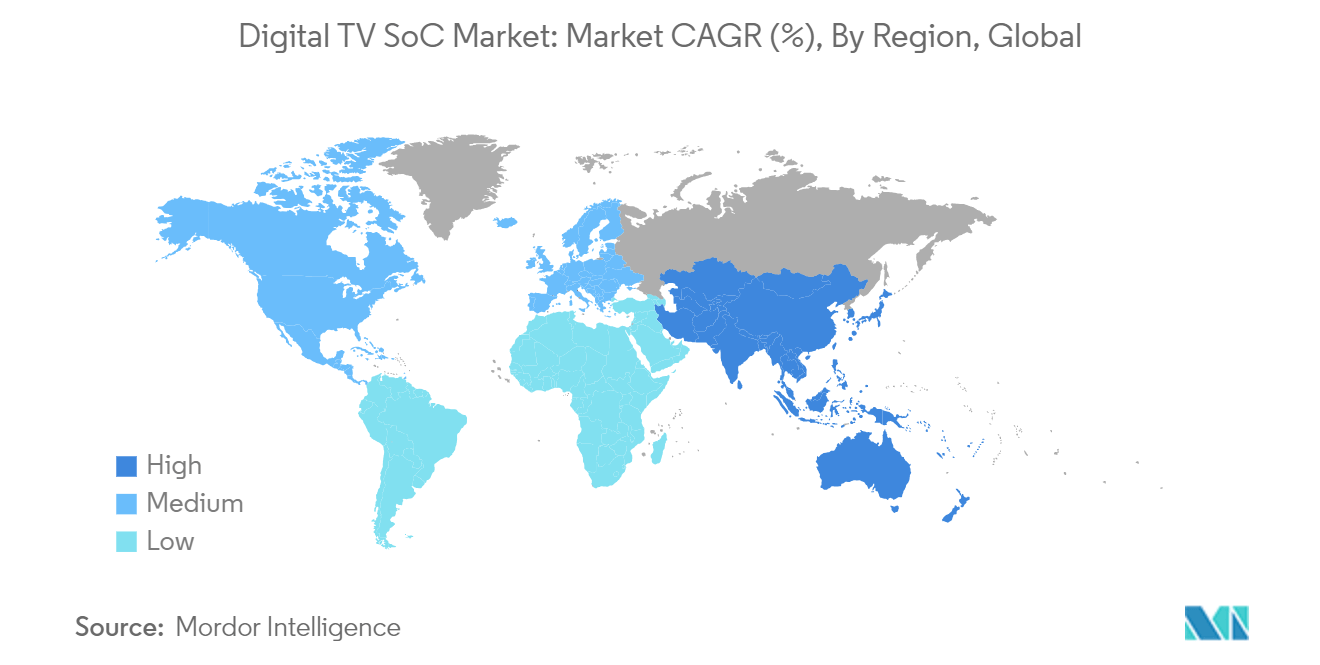
Digital TV SOC Industry Overview
The digital TV SoC market is highly fragmented, with global conglomerates and specialized players operating across various segments. While several large multinational companies dominate certain high-value segments, numerous regional and niche players contribute to the overall competition, making the market highly diverse. This fragmentation is driven by the wide range of applications for digital TV SoC, allowing both large and small companies to coexist and thrive in the market.
Leading companies in the digital TV SoC market include Broadcom Inc., STMicroelectronics NV, Samsung Electronics Co. Ltd, MediaTek Inc., and Qualcomm Technologies Inc. These companies have established strong brand recognition and extensive global operations, enabling them to command significant market share. Their strengths lie in innovation, broad product portfolios, and strong distribution networks. These leaders often engage in strategic acquisitions and partnerships to maintain their competitive edge and expand their market reach.
To succeed in the digital TV SoC market, companies must prioritize innovation as there is increased consumer demand for mobile gaming, streaming, and artificial intelligence functionalities such as facial recognition and edge processing. SoC is necessary to fulfill increased computational requirements. Companies that invest in emerging markets and adapt their products to regional needs are expected to gain a competitive advantage in this fragmented market.
Digital TV SOC Market Leaders
-
Broadcom Inc.
-
STMicroelectronics N.V.
-
Samsung Electronics Co. Ltd.
-
MediaTek Inc.
-
Qualcomm Technologies, Inc.
*Disclaimer: Major Players sorted in no particular order
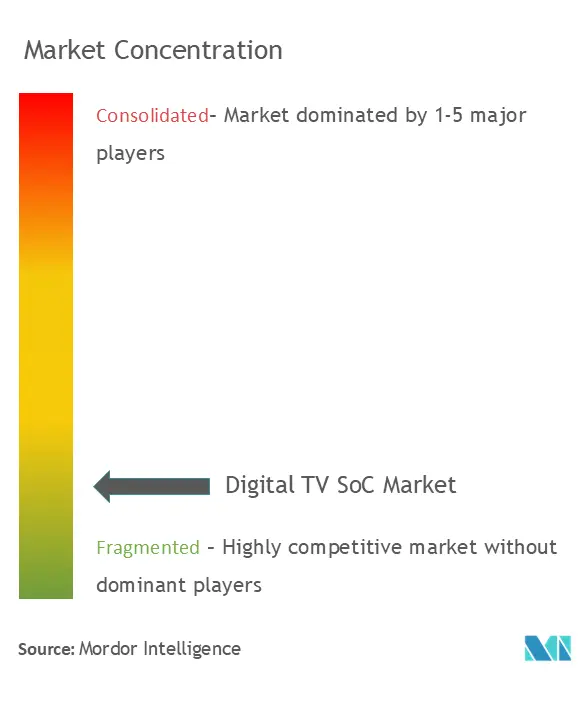
Digital TV SOC Market News
- May 2024: MediaTek announced its Dimensity 9300+ system-on-chip (SoC), representing the company's newest advancement in processors designed for premium mobile applications. This chipset is equipped with 18 MB of L3 cache and system-level cache (SLC), and it is compatible with the latest LPDDR5T memory, achieving speeds of up to 9,600 Mbps, as well as UFS 4.0 storage. These capabilities enable the device to execute high-speed operations and multitask efficiently without sacrificing performance.
- January 2024: Videocon d2h, a direct-to-home (DTH) service provider, partnered with MStar Semiconductor. Under this collaboration, MStar Semiconductor is expected to supply its high-efficiency video codec (HEVC) H.265 system-on-chip (SoC) for Videocon's high-definition set-top boxes (STBs). MStar Semiconductor effectively integrated HEVC technology into its HD solutions, significantly optimizing bandwidth usage while delivering superior picture quality. This partnership enables operators and STB original equipment manufacturers (OEMs) to lower their development expenses and accelerate their time to market, thereby addressing the demands of the Indian market with the MStar HEVC-capable set-top box SoC solution.
Digital TV SOC Market Report - Table of Contents
1. INTRODUCTION
1.1 Study Assumptions and Market Definition
1.2 Scope of the Study
2. RESEARCH METHODOLOGY
3. EXECUTIVE SUMMARY
4. MARKET INSIGHTS
4.1 Market Overview
4.2 Industry Attractiveness - Porter's Five Forces Analysis
4.2.1 Bargaining Power of Suppliers
4.2.2 Bargaining Power of Consumers
4.2.3 Threat of New Entrants
4.2.4 Threat of Substitute Products
4.2.5 Intensity of Competitive Rivalry
4.3 Industry Value Chain Analysis
4.4 Impact of COVID-19 Aftereffects and Other Macroeconomic Factors on the Market
5. MARKET DYNAMICS
5.1 Market Drivers
5.1.1 Increasing Demand for Smart TVs Will Drive the Market Growth
5.1.2 Rising Consumer Demand for High-definition and Ultra-high-definition (UHD) Content
5.2 Market Challenges
5.2.1 High Initial Cost of Design and Development
6. MARKET SEGMENTATION
6.1 By Application
6.1.1 LCD
6.1.2 LED
6.1.3 OLED
6.1.4 QLED
6.2 By End User
6.2.1 Residential
6.2.2 Commercial
6.2.3 Other End Users
6.3 By Geography***
6.3.1 North America
6.3.2 Europe
6.3.3 Asia
6.3.4 Australia and New Zealand
6.3.5 Latin America
6.3.6 Middle East and Africa
7. COMPETITIVE LANDSCAPE
7.1 Company Profiles
7.1.1 Broadcom Inc.
7.1.2 MediaTek Inc.
7.1.3 Intel Corporation
7.1.4 Qualcomm Technologies Inc.
7.1.5 Samsung Electronics Co. Ltd
7.1.6 STMicroelectronics NV
7.1.7 Novatek Microelectronics Corp.
7.1.8 MStar Semiconductor Inc.
7.1.9 LG Electronics Inc.
7.1.10 HiSilicon
7.1.11 NXP Semiconductors
- *List Not Exhaustive
8. INVESTMENT ANALYSIS
9. FUTURE OUTLOOK OF THE MARKET
Digital TV SOC Industry Segmentation
A digital TV system-on-chip (SoC) is an advanced electronic component that integrates multiple functionalities, including processing capabilities, memory storage, and interface connections, all within a single chip.
The study tracks the revenue accrued through the sales of digital TV SoC by various players in the global market. The study also tracks the key market parameters, underlying growth influencers, and major vendors operating in the industry, which support the market estimations and growth rates over the forecast period. The study further analyses the overall impact of COVID-19 and its aftereffects and other macroeconomic factors on the market. The report’s scope encompasses market sizes and forecasts for the various market segments.
The digital TV SoC market is segmented by application (LCD, LED, OLED, and QLED), end user (residential, commercial, and other end users), and geography (North America, Europe, Asia-Pacific, and Rest of the World). The market sizes and forecasts are provided in terms of value (USD) for all the above segments.
| By Application | |
| LCD | |
| LED | |
| OLED | |
| QLED |
| By End User | |
| Residential | |
| Commercial | |
| Other End Users |
| By Geography*** | |
| North America | |
| Europe | |
| Asia | |
| Australia and New Zealand | |
| Latin America | |
| Middle East and Africa |
Digital TV SOC Market Research FAQs
How big is the Digital TV SOC Market?
The Digital TV SOC Market size is expected to reach USD 11.13 billion in 2024 and grow at a CAGR of 12.90% to reach USD 20.42 billion by 2029.
What is the current Digital TV SOC Market size?
In 2024, the Digital TV SOC Market size is expected to reach USD 11.13 billion.
Who are the key players in Digital TV SOC Market?
Broadcom Inc., STMicroelectronics N.V., Samsung Electronics Co. Ltd., MediaTek Inc. and Qualcomm Technologies, Inc. are the major companies operating in the Digital TV SOC Market.
Which is the fastest growing region in Digital TV SOC Market?
North America is estimated to grow at the highest CAGR over the forecast period (2024-2029).
Which region has the biggest share in Digital TV SOC Market?
In 2024, the Asia Pacific accounts for the largest market share in Digital TV SOC Market.
What years does this Digital TV SOC Market cover, and what was the market size in 2023?
In 2023, the Digital TV SOC Market size was estimated at USD 9.69 billion. The report covers the Digital TV SOC Market historical market size for years: 2019, 2020, 2021, 2022 and 2023. The report also forecasts the Digital TV SOC Market size for years: 2024, 2025, 2026, 2027, 2028 and 2029.
Digital TV SOC Industry Report
Statistics for the 2024 Digital TV SOC market share, size and revenue growth rate, created by Mordor Intelligence™ Industry Reports. Digital TV SOC analysis includes a market forecast outlook for 2024 to 2029 and historical overview. Get a sample of this industry analysis as a free report PDF download.



